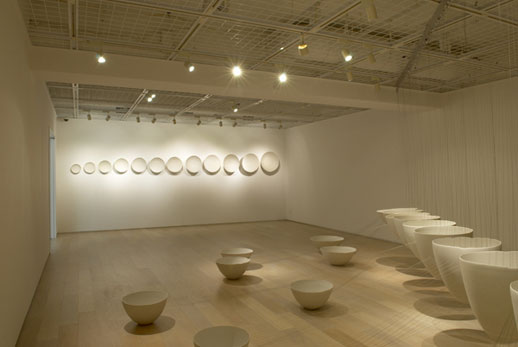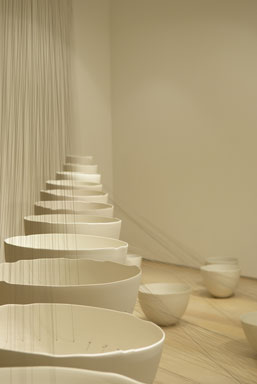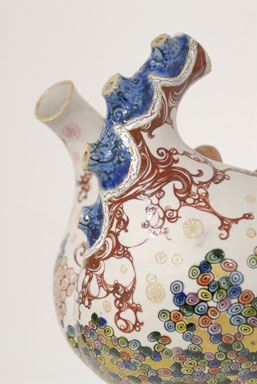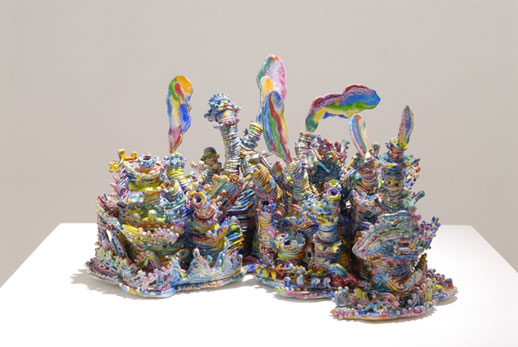Wobble is Everything
Two young female ceramic artists exhibiting at Kyobashi’s INAX Gallery could be an example of brilliance in contrast, both in ceramics and curatorial practice.
In Gallery Two, Fuku Fukumoto’s wide-rimmed, delicately tapered vessels capture perfectly what heart-stopping beauty can arise in the smallest fluctuation from centrifugal force. The photos you see here can barely do them justice; you really need to step around them, get down to eye level and make personal contact. Effortless consistency in Japanese crafts is one aspect to be admired but, in Fukumoto’s case, the wobble is all.

Where then, did INAX get the idea of drilling through these vessels and stringing them up from the ceiling on cables? Surely not from the artist herself? Since balance in ceramics is necessarily rooted at the base or foot of the object, hoisting them into mid-air on strings like a tacky David Copperfield illusion seems a little bit Hollywood: fake, showy and impervious to the formal grace of the object when set on the floor.
In Japan, books tell us, the distinction between art and artisanship is traditionally nonexistent. The potter is an artist and the painter a master of his craft. This absence of demarcation resulted in jaw-dropping aesthetic standards in pots and utensils: objects considered merely functional in the West. The message from INAX is that now there is a distinction. The Japanese audience is no longer impressed by skill in craftsmanship; there must also be fireworks, irreverence, some clever human repudiation of the laws of physics. What sense is there in inflicting damage to the surface of these vessels, effectively destroying their function for the sake of an illusion that is hardly convincing anyway? Is the weightlessness of objects normally considered heavy meant to induce Zen-like meditations on surface reality? If so, why these objects? Why not bowling balls or abandoned PC monitors?


In much the same way, wall-mounted displays of her work only subtract in pleasure what they add in drama. Who looks at ceramic vessels from the top down? This is how birds see them, not humans. It’s enough to show how the divine instrument of the human body, the hand, created form out of flattened earth. A vessel arises from its base; it does not hover or cling to walls unless artists and curators compel it to.

Running concurrently in INAX’s Galería Cerámica, the exhibition of Ai Hanazuka’s colourful, glazed creations is something else entirely. While Fukumoto was all about the pure white surface, Hanazuka can’t bear to leave any surface undecorated. If Fukumoto is the first generation iPod of the Japanese ceramic world, Hanazuka must be the jewel-bedecked bling cellphone in the hands of a young woman clattering down the station steps on stiletto heels.
At first glance, you think you’re in known territory. Hanazuka is the Japanese manifestation of a very foreign phenomenon: the seashore eccentric, the madwoman of the beach who decorates her home with shells. On the second glance, you see that Hanazuka’s creations do not simply spring from the decorating impulse: there are real considerations of form here. Lung-like casings abound with protruding valves and there are landscapes of organic architecture supported on mad stilts. Is that really a fantastically adorned internal organ or is it just another undersea kingdom in miniature? Depending on your take on scale, it could probably be either. This is a trippy, fascinating display of work that, unlike Fukumoto’s, is presented plainly and without curatorial whims. Expect to see it encased in formaldehyde by the closing weekend.



